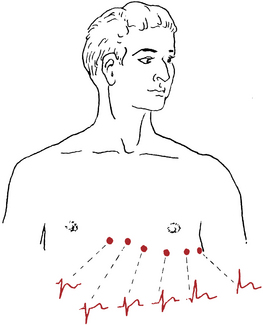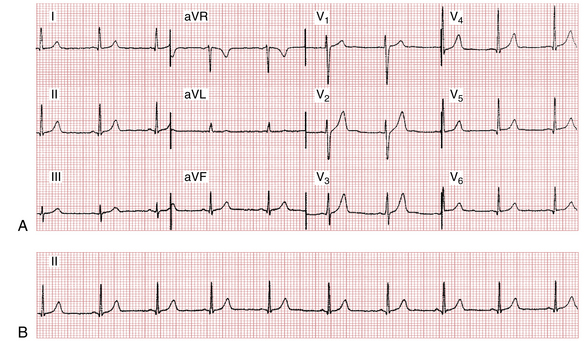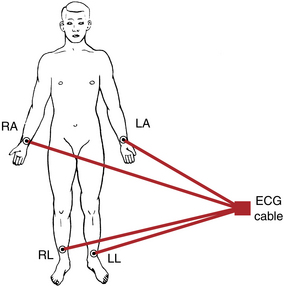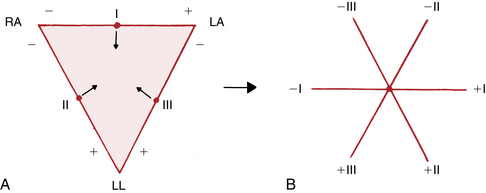Chapter 3 ECG Leads
Please go to expertconsult.com for supplemental chapter material.
As discussed in Chapter 1, the heart produces electrical currents similar to the familiar dry cell battery. The strength or voltage of these currents and the way they are distributed throughout the body over time can be measured by a suitable recording instrument such as an electrocardiograph.
Taking an ECG is like recording an event, such as a baseball game, with an array of video cameras. Multiple camera angles are necessary to capture the event completely. One view is not enough. Similarly, multiple ECG leads must be recorded to describe the electrical activity of the heart adequately. Figure 3-1 shows the ECG patterns that are obtained when electrodes are placed at various points on the chest. Notice that each lead (equivalent to a different camera angle) presents a different pattern.
Figure 3-2 is an ECG illustrating the 12 leads. The leads can be subdivided into two groups: the six limb (extremity) leads (shown in the left two columns) and the six chest (precordial) leads (shown in the right two columns).
Limb (Extremity) Leads
Standard Limb Leads: I, II, and III
The extremity leads are recorded first. In connecting a patient to an electrocardiograph, first place metal electrodes on the arms and legs. The right leg electrode functions solely as an electrical ground, so you need concern yourself with it no further. As shown in Figure 3-3, the arm electrodes are attached just above the wrist and the leg electrodes are attached above the ankles.
Lead II records the difference between the left leg (LL) and right arm (RA) electrodes:
Lead III records the difference between the left leg (LL) and left arm (LA) electrodes:
Leads I, II, and III can be represented schematically in terms of a triangle, called Einthoven’s triangle after the Dutch physiologist (1860-1927) who invented the electrocardiograph. At first the ECG consisted only of recordings from leads I, II, and III. Einthoven’s triangle (Fig. 3-4) shows the spatial orientation of the three standard limb leads (I, II, and III). As you can see, lead I points horizontally. Its left pole (LA) is positive and its right pole (RA) is negative. Therefore, lead I = LA − RA. Lead II points diagonally downward. Its lower pole (LL) is positive and its upper pole (RA) is negative. Therefore, lead II = LL − RA. Lead III also points diagonally downward. Its lower pole (LL) is positive and its upper pole (LA) is negative. Therefore, lead III = LL − LA.
In other words, add the voltage in lead I to that in lead III and you get the voltage in lead II.∗
You can test this equation by looking at Figure 3-2. Add the voltage of the R wave in lead I (+9 mm) to the voltage of the R wave in lead III (+4 mm) and you get +13 mm, the voltage of the R wave in lead II. You can do the same with the voltages of the P waves and T waves.
Thus, in electrocardiography, one plus three equals two.
In Figure 3-5, Einthoven’s triangle has been redrawn so that leads I, II, and III intersect at a common central point. This was done simply by sliding lead I downward, lead II rightward, and lead III leftward. The result is the triaxial diagram in Figure 3-5B. This diagram, a useful way of representing the three bipolar leads, is employed in Chapter 5 to help measure the QRS axis.















